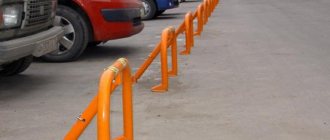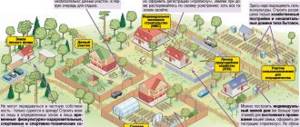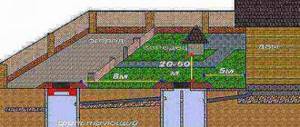What thickness of asphalt should be on the road
The thickness of the asphalt pavement according to SNiP must correspond to the purpose of the asphalted area. There are specific standards and technologies for asphalting the site of a private house, parking lots, and highways.
Thickness of asphalt laying in a private yard
In the courtyard of a private house there is no need for a multi-layer canvas, since this area is not intended for the movement of cars or heavy equipment. According to GOST, the thickness of the asphalt laid in the yard must be at least 4 cm. If these requirements are violated, after winter the coating will crack and repairs will have to be made. Before asphalting, workers must level the area and make a sand-crushed stone base.
Thickness of asphalt pavement in parking lot
The parking lot is intended for parking cars of different carrying capacity and weight, so the thickness of the asphalt coating layer must be at least 6 cm. The asphalt road must withstand high loads from standing cars.
It is especially important to comply with these requirements when paving parking lots near large shopping centers, high-rise office buildings, and public places. The surface is first leveled, cleaned, a sand cushion is formed, and then an asphalt mixture is laid.
Thickness of asphalt road surfaces
For roadways, the requirements according to GOST are higher than for other sections. The minimum thickness of asphalt on roads is 8 cm. On busy highways and highways, each layer must be at least 10 cm.
On highways, the asphalt mixture is laid in several layers:
- first layer: 4-8 cm;
- second layer: 4-6 cm.
Bitumen emulsion must be distributed between the layers to ensure better adhesion of the material. If the asphalt laying thickness is observed, repairs will not be required for several years.
What should be the thickness of crushed stone for asphalt?
If we talk about roads on which cars drive, including multi-ton trucks, and not about pedestrian paths, then the preparation technology before laying asphalt is much more complicated. If the fertile layer of soil has already been removed and the sand cushion has already been compacted, then the next stage will be crushed stone flooring. Crushed stone will be required in different fractions. The total layer should be 25-35 cm. The first layer of crushed stone should be from a fraction of 40-70 mm. It will also serve as drainage from groundwater. It will be about 20 cm. The next layer of the 20-40 mm fraction is 5-10 cm thick. This smaller crushed stone will ensure even distribution of the load when rolling the road. Many builders also lay down a third layer from a fraction of 5-20 mm up to 5 cm thick. Now you can lay the asphalt.
The thickness of the cushion of crushed stone and asphalt layer depends on the expected load on the road surface. If the asphalt path is for pedestrians and cyclists, then a thickness of a layer of crushed stone (middle fraction) of 15 centimeters is sufficient, on which only one layer of asphalt is laid.
Thickness of asphalt pavement according to GOST
The thickness of layers and technologies for laying asphalt are regulated by GOST and SNiP. According to state standards, asphalt pavement is divided into several classes, which presuppose their load and thickness of the asphalt road.
Types and thickness of asphalt according to GOST on the road:
- first class: withstands heavy loads, suitable for roads with heavy traffic, each layer must be at least 4 cm, there can be from 2 to 4 layers in total;
- second class: suitable for asphalt parking lots, pedestrian areas, sidewalks, bicycle paths, playgrounds: each layer must be at least 2.5 cm, a total of 2 or 3 layers are laid;
- third class: the coating is used in private courtyards, on children's and sports grounds, in recreation areas, each asphalt layer must be at least 1.5 cm, traffic on such roads is prohibited.
There are separate recommendations for each asphalt paving method, which also need to be taken into account when laying asphalt. But the general rules for calculating the thickness of asphalt pavement remain unchanged:
- yard: 4-5 cm;
- parking: 6 cm;
- highway: 8 cm.
If the specified proportions and rules are observed, the roadway will last for many years and will not require major repairs.
Base and thickness of asphalt
We already know that we need to take into account not only the base material, but also not forget about the load. So, if the base is made of concrete, then a 6-centimeter layer of asphalt is enough to create a high-quality road surface, which is designed for small and medium loads. If you use crushed stone or broken brick as a base, then the lower threshold for the height of the asphalt layer varies from 12 to 18 cm: depending on whether it is a simple road or a highway (in the latter case, the base must be at least 30 cm).
A layer of asphalt with a thickness of 18 to 30 cm can withstand the load on busy highways; in this case, concrete or crushed stone of 4-5 different fractions serves as the base material. Take these standards into account when planning construction and budget, and then the coating will serve you for a long time, and you will spend exactly as much on the material as required.
What is included in the task of paving the local area?
Massive measures for paving courtyards were taken in 2011, when the Russian Government issued a decree of March 2011 under No. 139.
- Asphalting of courtyard areas adjacent to the roadway.
- Arrangement of sidewalks.
- Creation of car parking spaces.
- Separation of asphalted areas of transport and pedestrian traffic by markings or side stones.
The requirements for asphalt concrete in the yard are no different from the requirements for main roads. The only difference is that the level of transport load will be lower, therefore the thickness for laying asphalt may be slightly less.
Roadway clothing – what is it?
The roadway has clothing. How to interpret this concept? Roadway coverings are layers of different materials, the purpose of which is to create a smooth surface. It is clear that roads are constantly in use, which means that their condition must be carefully monitored to prevent the occurrence of any life-threatening, undesirable conditions.
Road clothing can be divided into 2 layers: upper and lower. The upper one is subject to more loads, so more durable materials are used to create it than for the lower one. Thanks to the base layer, which usually includes inexpensive materials, the cost of roads is significantly reduced, while the quality also decreases.
Clothing for the road can be hard; this includes materials that can resist the movement of wheels, otherwise called cement concrete. Another option for clothing is not rigid. Such clothing is usually made from grainy materials that are knitted or practically non-knitted. Typically such materials are reinforced with additives such as cement or lime.
Upper layer
The top layer of the road is a coating that is subject to loads from the wheels of a car, so its function is protective. Such a layer is always hard, because it is subject to destruction, shifts, and so on. The top layer should be as smooth as possible, because it is what provides adhesion to the road surface and the car's wheels. Grip can be improved by applying wear to the top layer, which is changed over time to provide better grip.
Types of clothing
There are several types of pavement, which are usually selected depending on the following factors:
- Road category.
- Are there imported materials?
Types of clothing can also be distinguished by the materials used, for example:
- soil into which grain additives are added (crushed stone, sand);
- coarse grain materials (crushed stone, gravel);
- crushed stone materials (gravel, stone or crushed stone);
- local soil, which is treated with binders;
- imported materials (concrete slabs);
- a mixture of stone materials with cementitious materials.
Read on topic: Where to complain about bad roads
Both crushed stone and gravel are fairly loose materials that become strong only after they are compacted. This occurs due to the fact that the particles rub and bond with each other using a binder material.
Road works technologies
Proportions and manufacturing standards are regulated by GOST, but many manufacturers ignore this rule and use cheap substitutes. This does not reflect well on the quality of the asphalt mixture, so it is preferable to order this product from truly trusted companies, for example, representative offices.
According to GOST requirements, asphalting of roads and sidewalks must be carried out under suitable weather conditions. The production of the mixture is also determined by the standards of these documents. Laying asphalt SNIP (building codes and regulations) also determines the quality of the finished work, from the stage of preparatory work to the final cycle.
Laying asphalt
To prepare the base for asphalt, you can also use reinforced concrete slabs and/or a concrete foundation poured from monolithic concrete. This method of preparation for asphalting is used quite rarely because it is much more expensive. Asphalting with a reinforced concrete base is done during the construction of runways in the aircraft industry.
As soon as the asphalt is delivered to you by dump truck, you must immediately begin laying it. You can use an asphalt paver for these purposes. Narrow paths are covered with asphalt using a shovel, and then compacted using a vibrating plate. Based on the thickness of the asphalt, immediately after spreading it over the surface, compaction should immediately begin with self-propelled or manual devices.
We recommend reading: What to consider when buying an apartment
Asphalting the yard of a private house: more about the process
For example, if an area near a house is being prepared for parking and driving a car, then it is necessary to asphalt it in two layers, and the crushed stone base should reach from 25 cm to half a meter. And when paving pedestrian paths, you don’t have to build a serious foundation; only 10 cm of crushed stone is enough, so asphalt paths will cost several times less.
- Excavation work involves leveling and clearing the base, in which the top layer of soil is removed using a shovel or bulldozer.
- Marking the plan, which involves drawing a diagram of the passage of a car and pedestrian paths near the house, respectively - the contours of the asphalt.
- Backfilling future paths and sites (clay, sand, gravel).
- Compacting and rolling sand and gravel mixture.
- Installation of curb and parking barriers.
- Directly pouring asphalt, compacting it and rolling it.
We recommend reading: Children's train tickets
Technology for laying asphalt (road surface)
The finished asphalt concrete mixture is delivered to the site by dump trucks. Depending on the brand of dump truck, it is capable of delivering from 7 to 20 tons of asphalt. From 1 ton of asphalt, an average of 10 m2 of asphalt concrete pavement 4 cm thick is obtained. So, asphalt is delivered, then manually or using special machines - asphalt pavers - distributed over a given area, leveled, leveled and compacted using rollers, vibrating plates, and compactors.
In the case of asphalt concrete pavement intended for high loads, rollers of 6-10 tons or higher must be used to compact the base and then the asphalt concrete. For smaller loads, rollers of 2-4 tons are sufficient. It should be remembered that in modern rollers the vibration function significantly increases the compaction ability (about 3-4 times!). Vibrating plates and vibrating rammers can also be used for compaction in hard-to-reach places. To improve the quality of compaction, the base should be moistened. At large facilities, watering machines are used for this.











